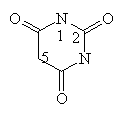
The Development of Barbiturates
In 1864 a German chemist Adolph von Baeyer synthesized the fist barbiturate, barbituric acid. This itself had no therapeutic properties but its discovery led to the derivation of many other compounds that were therapeutically significant.

The first active barbiturate was synthesized in 1903 by Fischer and von Mering. This was achieved by substituting two ethyl groups for the two hydrogen atoms attached to the carbon. When taken by humans this barbiturate was found to induce sleep. The problem, however, was that it was very slow to take effect and also very slow to wear off so people who took it may have ended up sleeping for a couple of days!
Further research discovered that the lack of therapeutic properties in barbituric acid and the slow acting effect of other barbiturates was due to the slow transfer of the chemicals between the intestines and the blood. The intestine walls are made of fatty molecules so for the transfer to occur faster it was necessary to develop barbiturates containing larger hydrocarbon groups which would resemble these fatty compounds.

The length of the chain and the position it was substituted in varied the properties of the barbiturates. Substitution at the five position resulted in longer acting barbiturates with the shorter chains being active for longer. This substitution is also responsible for controlling hypnotic activity. If sulphur was substituted instead of oxygen at position two, the onset of activity would be more rapid and the duration of the activity would be shorter.